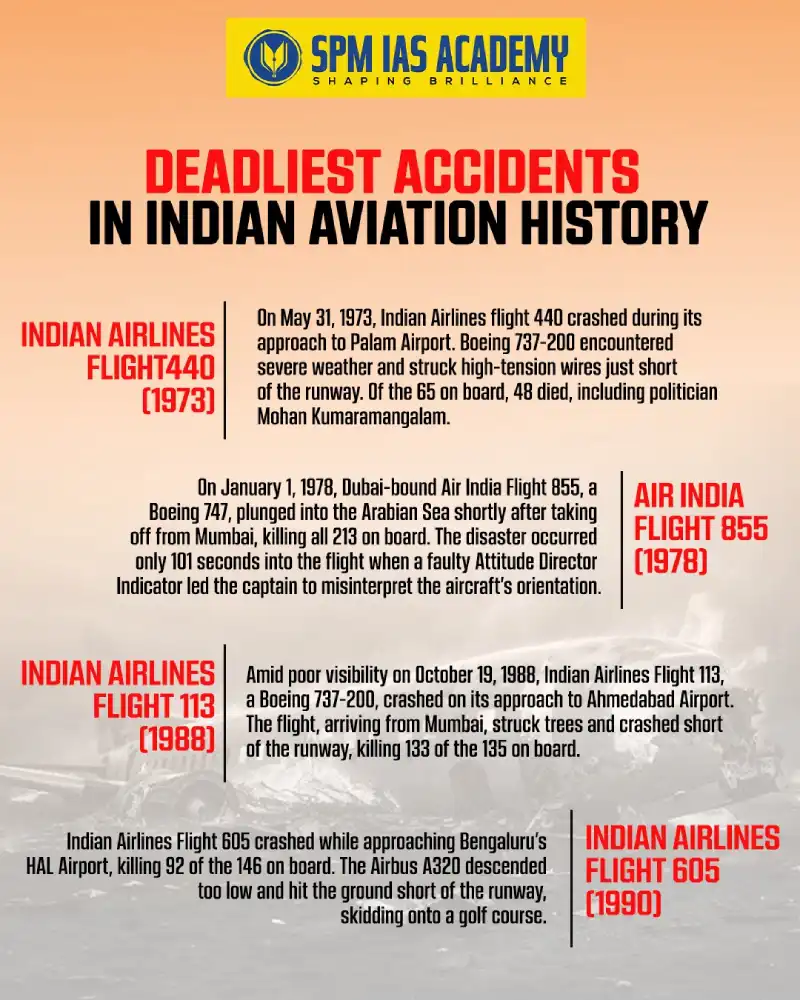Why in the News?
The Air India Flight (AI-171), en route to London Gatwick, had a recent accident in Ahmedabad. This incident has left everyone in a state of shock. The accident calls for a thorough check of the Indian airline's safety. The nation has demanded that the Ministry of Civil Aviation address India’s Aviation safety.
India’s Aviation Safety: Overview
India is the third-largest domestic aviation market in the world. The U.S. is the largest, with China coming in second place. The country has over 240 million passengers flying each year. Moreover, this number is only expected to reach 500 million by 2030. In addition to passenger travel, India is also expanding its cargo capacity. India has goals to triple freight movement from 3.5 million to 10 million metric tons annually by 2030.
India is dominating South Asia’s airline traffic with a 69% market share. Further, it highlights the country’s aviation supremacy in the area.
Indian aviation has an important economic influence. It has an annual contribution of roughly USD 53.6 billion and 1.5% of the country’s GDP. In addition to its direct financial contributions, the industry supports an estimated 7.7 million jobs. India is a major employer, as its aviation industry contributes to 8.9% of all jobs.


I. What is the Importance of India’s Aviation Safety?
Below are some of the reasons why Indian airline safety is important:
1. Passenger Confidence and Public Trust:
Ensuring the safety of passengers and crew is the most important factor. More people choose air travel when there is a strong safety record. A single significant incident can seriously damage public confidence. This can have a detrimental effect on passenger traffic.
2. Development and Economic Growth:
The aviation industry of India contributes largely to the development and economic growth of the country.
- Encouraging Trade and Commerce: Many businesses depend on safe and effective air transportation. It facilitates trade, foreign investment, and the nation’s general economic growth. Airlines enable the rapid movement of people and products, particularly high-value cargo such as electronics, medications, and perishables.
- Supporting the Aviation Sector: Indian airlines can attract passengers and remain competitive by maintaining a solid reputation for safety. Accidents can negatively impact the profitability and expansion of airlines. This is because accidents lead to fleet groundings, investigations, and financial fines.
- Employment Creation: The aviation industry employs a large number of people both directly and indirectly. Job stability and new prospects in maintenance, manufacturing, airports, airlines, and allied services are guaranteed by a safe and expanding sector.
- Foreign Direct Investment (FDI): If foreign investors believe that a nation’s airlines and aviation infrastructure are safe and compliant with regulations, they are more inclined to invest. Foreign investment is discouraged by a lack of safety measures.
3. Tourism Promotion:
India’s aviation sector significantly contributes to increasing the tourism value in the country.
- Foreign Visitors: For foreign visitors to India, air travel is the primary means of transportation. A strong tourism industry helps the economy and creates jobs. To thrive, it needs a safe aviation system.
- Domestic Travellers: As disposable incomes increase, more Indians are opting for leisure flights. Ensuring safety promotes internal travel, which links the many regions of the large nation and strengthens local economies (e.g., through schemes like UDAN).
4. Adherence to Global Standards:
India is a member of the International Civil Aviation Organisation (ICAO) and a signatory to the Chicago Convention. Remaining in compliance with the ICAO’s Standards and Recommended Practices (SARPs) and fulfilling international commitments depend on maintaining high aviation safety standards.
5. Maintaining Category 1 Status:
International organisations evaluate nations regularly. One of these organisations is the US Federal Aviation Administration (FAA). They assess the capacity of nations to supervise aviation safety. Safety compliance is very important for airlines. Indian airlines must maintain their “Category 1” certification. This certification is necessary for them to operate in countries like the US. Maintaining this certification helps them grow their services.
II. What are the Challenges of Flight Safety in India?
Below are some of the challenges faced by India’s aviation safety:
1. Technical issues: The Ahmedabad disaster was probably caused by incorrect configuration (flaps, thrust, gear) and heat (43°C).
2. Training for pilots: Insufficient checks and communication (CRM).
3. Facilities: Lack of buffer zones, outdated technology, and dilapidated runways.
4. Regulatory weaknesses: DGCA India’s lack of resources and limited capacity are regulatory vulnerabilities.
5. Commercial pressures: Disregarding safety regulations to cut expenses.
What are the Regulatory Bodies in Indian Aviation?
The Ministry of Civil Aviation in India is governed by a thorough regulatory system made up of multiple specialised organisations. Each of these bodies has specific duties, thus guaranteeing operational effectiveness, safety, and security of India’s aviation safety.
1. Directorate General of Civil Aviation (DGCA)
With overall responsibility for safety supervision and regulatory enforcement, the DGCA India is the leading civil aviation regulatory organisation. Its primary roles include:
- Formulating airworthiness standards
- Licensing aviation personnel
- Certifying aerodromes and air traffic management facilities
- Granting Air Operator’s Certificates to airlines.
The DGCA India also conducts investigations, including smaller incidents. Meanwhile, it implements accident prevention measures through Safety Management System (SMS) programmes. Together with its coordination with ICAO focuses on regulatory functions and compliance with international standards. Hence, the DGCA India is the cornerstone of India’s aviation safety framework.
2. Air Authority of India (AAI)
The Air Authority of India (AAI) is a statutory body under the Ministry of Civil Aviation. The AAI is significantly responsible for managing India’s civil aviation infrastructure. It particularly provides air traffic management services and manages airports and terminals.
The Air Authority of India is an airport developer in India. They are responsible for designing, developing, and operating airports. They also manage cargo terminals and air navigation services. Accordingly, their main goal is to ensure safety and efficiency in Indian airspace.
3. Aircraft Accident Investigation Bureau (AAIB)
The AAIB was established on 30 July 2012. It serves as India’s statutory investigative body under the Ministry of Civil Aviation. Prior to its main duty is to investigate aircraft accidents and serious incidents in Indian airspace, the bureau operates under the Aircraft (Investigation of Accidents and Incidents) Rules, 2017. These rules are straightaway aligned with the standards set by the International Civil Aviation Organization (ICAO).
The AAIB’s core functions are:
- Classifying aviation occurrences
- Preparing public final reports
- Issuing safety recommendations to the DGCA
- Conducting systemic safety studies.
4. Bureau of Civil Aviation Security (BCAS)
The BCAS was reorganized in April 1987. It serves as the regulatory authority for the Bureau of Civil Aviation Security in India. Accordingly, its responsibilities include establishing aviation security standards in accordance with ICAO. BCAS also monitors the implementation of security measures. Additionally, it conducts surprise checks to test security preparedness across airports and airlines.
Chronological List of Indian Aviation Accidents and Incidents
| Date | Description | Casualties | Survivors |
|---|---|---|---|
| June 12, 2025 | Air India passenger plane crash in Gujarat – details currently unknown. | Unknown | Unknown |
| April 2, 2025 | An IAF Jaguar fighter jet crashed during training near Jamnagar Air Force Station. | 1 | 1 |
| June 3, 2019 | IAF An-32 crashed in Arunachal Pradesh’s hilly terrain after contact loss. | 13 | 0 |
| Aug 7, 2020 | Air India Express Flight 1344 (Dubai–Kozhikode) overshot the Calicut runway and broke apart. | 18 | 172 |
| July 22, 2016 | IAF An-32 went missing over the Bay of Bengal. | 29 | 0 |
| May 22, 2010 | Air India Express Flight 812 (Dubai–Mangalore) overshot the runway and fell into a gorge. | 158 | 8 |
| July 17, 2000 | Alliance Air Flight 7412 crashed into the Patna residential area due to a stall on approach. | 60 (55+5) | – |
| Dec 24, 1999 | IC-814 was hijacked to Kandahar by terrorists; one passenger was killed, and 192 survived. | 1 | 192 |
| Nov 12, 1996 | Charkhi Dadri mid-air collision between Saudi and Kazakh planes; the deadliest mid-air crash in history. | 349 | 0 |
| Apr 26, 1993 | IC-491 crashed into a truck while taking off from Aurangabad. | 55 | – |
| Apr 24, 1993 | IC-427 hijacked; hijacker killed after security stormed the plane in Amritsar. | 1 | 140 |
| Apr 10, 1993 | IC Boeing 737 hijacked by four students with minor weapons; all passengers safe. | 0 | 59 |
| Mar 27, 1993 | IC-439 hijacked en route to Madras; the hijacker surrendered in Amritsar. | 0 | 203 |
| Jan 22, 1993 | IC-810 hijacked over Babri Masjid demands; surrendered after negotiations. | 0 | 54 |
| Aug 16, 1991 | IC-257 crashed on descent into Imphal due to pilot error. | 69 | 0 |
| Feb 14, 1990 | IC-605 crashed during approach to Bangalore; pilot error was the cause. | 92 | – |
| Oct 19, 1988 | IC-113 crashed near Ahmedabad during final approach. | 130 | – |
| Aug 14, 1984 | IC-421 hijacked to the UAE by Sikh militants; passengers later released. | 0 | 74 |
| July 5, 1984 | IC-405 hijacked to Lahore by Khalistan supporters; surrendered. | 0 | 264 |
| Aug 20, 1982 | A Sikh militant hijacked a Jodhpur–Delhi flight and was killed by security. | 1 | 68 |
| Aug 4, 1982 | IC Delhi–Amritsar hijacked by militants with a fake bomb; overpowered. | 0 | All |
| Jun 21, 1982 | Air India Flight 403 crashed at Bombay in heavy weather. | 17 | 94 |
| Nov 26, 1981 | AI Flight 224 hijacked in Seychelles by fleeing mercenaries; passengers released. | 0 | 78 |
| Sep 29, 1981 | IC-423 hijacked to Lahore by Sikh extremists; no casualties. | 0 | 117 |
| Dec 20, 1978 | IC-410 hijacked to protest Indira Gandhi’s arrest; later, politically rewarded. | 0 | 132 |
| Jan 1, 1978 | Air India Flight 855 crashed off the Bombay coast after an instrument failure. | 213 | 0 |
| Oct 12, 1976 | IC-171 crashed at Bombay after an uncontained engine fire. | 95 | 0 |
| Sep 10, 1976 | IC hijacked by Kashmiri militants, plane landed in Lahore, hijackers drugged. | 0 | 83 |
| May 31, 1973 | IC-440 crashed on approach to Palam Airport. | 48 | 17 |
| Sep 24, 1972 | Japan Airlines Flight 472 landed at the wrong airport and overran the runway. | 0 | 122 |
| Jun 14, 1972 | Japan Airlines Flight 471 crashed near Palam Airport, sparking a disagreement over the cause. | 85 (82+3) | 5 |
| Jan 30, 1971 | IC hijacked to Lahore; passengers released, plane destroyed. | 0 | 32 |
| Sep 19, 1965 | Civilian Beechcraft shot down by Pakistan Air Force over Gujarat. | 8 | 0 |
| Jul 28, 1963 | US Flight 869 crashed off Bombay due to turbulence and weather. | 63 | 0 |
| Jul 7, 1962 | Alitalia Flight 771 crashed near Mumbai due to a navigation error. | 94 | 0 |
| May 25, 1958 | Dan-Air Avro York crashed in Gurgaon after an in-flight fire broke out. | 4 | 1 |
| Jul 12, 1949 | KLM Lockheed crashed near Ghatkobar during an approach in bad weather. | 45 | 0 |
| Aug 14, 1943 | Tata Airlines plane crashed near Lonavala; 6 killed. | 6 | 0 |
| Mar 7, 1938 | Air France Potez 62 crashed outside Datia due to an in-flight fire. | 7 | 0 |
Deadliest Indian Aviation Incidents
- Charkhi Dadri mid-air collision (1996) – 349 dead (worst mid-air crash globally)
- Air India Flight 855 (1978) – 213 dead
- Air India Express 812 (2010) – 158 dead
- IC-113 Ahmedabad crash (1988) – 130 dead
- Alliance Air 7412 crash (2000) – 60+ dead
What are the Key Initiatives for India’s Aviation Safety?
1. Rapid Expansion and Infrastructure Development: India has doubled its number of operational airports. Accordingly, the number grew from 74 in 2014 to 160 by 2025. Furthermore, this includes heliports and water aerodromes. Major expansion projects are taking place at Varanasi Airport. There are also new civil enclaves being developed at Bihta (Patna) and Bagdogra.
2. Digital Transformation: By the same token, the Digi Yatra application facilitates smooth travel through facial recognition technology. This improves both security and efficiency. Besides, the eGCA platform has transformed nearly 300 aviation services into digital formats. Additionally, it simplifies regulatory procedures.
3. Policy and Industry Growth:
- Bharatiya Vayuyan Adhiniyam (2024) aims to modernize aviation laws and boost indigenous manufacturing.
- The Protection of Interest in Aircraft Objects Bill grants legal authority to the Cape Town Convention and Protocol (2001), strengthening aircraft leasing and financing.
4. National Aviation Safety Plan (2024-28): Provided that strategic direction for the management of Indian airline safety, it contains the five National Goals:
- Goal 1: To achieve a continuous reduction of operational safety risks
- Goal 2: To strengthen safety oversight capabilities
- Goal 3: Implementation of an effective State Safety Programme.
- Goal 4: Increase collaboration at the international level
- Goal 5: Expand the use of industry programmes and safety information sharing networks by service providers.
What is the Way Forward for India’s Aviation Safety?
Addressing the multifaceted challenges revealed by the Air India plane crash requires a holistic approach. This approach should encompass regulatory strengthening. It also needs to focus on human resource development. Additionally, infrastructure modernization is essential.
1. Strengthening Regulatory Oversight
Recently, the DGCA has started “Comprehensive Special Audits” to improve regulatory oversight. These audits need to be carefully enforced. Coupled with this, there should be strict penalties for those who do not comply. So, increasing transparency in audit results is important. Investigation reports should also align with ICAO standards. This will help build public trust and accountability.
2. Enhancing Human Resource Development
Lack of skilled aviation professionals could be another reason. To address this issue, we need to expand the scope of Flight Training Organizations. Additionally, we should increase the number of commercial pilot licenses issued. Hence, it is important to apply strict rules for Flight Duty Time Limits. We also need to provide complete psychological support programs for crew members. Further, these programs will help manage risks related to fatigue.
3. Modernizing Infrastructure and Technology
In addition, airports should focus on upgrading their existing facilities. Together with this, they need to include modern safety equipment and systems. Accordingly, it is important to modernize the Air Traffic Control infrastructure. As a result, new communication and navigation systems are necessary for better traffic management.
4. Fostering Proactive Safety Culture
Another key point is that the industry needs to change from waiting for problems to happen to preventing them. Hence, we must focus on preventing issues. Furthermore, this requires setting up regular safety checks. Airlines should prioritize passenger safety above all else.
Conclusion
In essence, the AAIB report on the Air India crash underscores the urgent need for improved safety in Indian aviation. Moreover, the tragedy highlights the importance of reforming Indian airline safety management. This can be achieved through better technology, human factors, and regulatory oversight.
Further, as India’s aviation sector grows, investing in India’s Aviation safety and infrastructure is important. This incident could be a pivotal moment. The tragic loss of so many people shows the urgent need to strengthen protocols and ensure passenger safety, ultimately enhancing India’s global aviation standing.
Frequently Asked Questions
A: Components Key Point
✔️Safety Policy.
✔️Safety Risk Management.
👍Safety Assurance.
👍Safety Promotion.
A: The 5/20 rule is a standard set by the Indian Ministry of Civil Aviation. It requires national airlines to have at least five years of flying experience. Additionally, the airlines must have a minimum of 20 aircraft to operate international flights. This rule applies to all commercial airlines that carry passengers.
A: India is now the third-largest aviation market in the world. It handles 241 million passengers in 2024, according to the International Air Transport Association (IATA).
A: According to the DGCA’s audit, SpiceJet is the safest airline in India. It had the fewest issues, with only 14 problems, none of which were severe enough to be classified as Level 1 issues. The fastest airlines are Tata Singapore Airlines and IndiGo.
A: We advise you to exercise caution when travelling in India. Please do not go to the Union Territory of Jammu and Kashmir, the India-Pakistan border, or Manipur.












